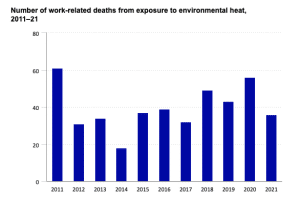
Heat Stress in the Workplace: A Deep Dive into Deaths, Injuries, and Solutions
Heat stress in the workplace is a growing concern, particularly as global temperatures rise due to climate change. Each year, thousands of workers suffer from heat-related illnesses and injuries, and tragically, many lose their lives. This blog post explores the alarming statistics surrounding heat-related deaths and injuries in the workplace, drawing on data from the Bureau of Labor Statistics (BLS) and other reputable sources. We’ll examine trends, the industries and demographics most affected, real-world examples, and the measures that can prevent these incidents. Additionally, we’ll discuss the broader economic and social impacts of heat stress, its global context, and the critical role of climate change in exacerbating the problem.
The Stark Reality: Heat-Related Deaths and Injuries in the Workplace
Fatalities: A Closer Look at the Numbers
According to the Bureau of Labor Statistics (BLS), there were 36 work-related deaths due to environmental heat exposure in 2021, as detailed in their report titled 36 Work-Related Deaths Due to Environmental Heat Exposure in 2021. This figure highlights the deadly consequences of inadequate heat safety measures. However, this is not an isolated occurrence. Historical data from the BLS’s Census of Fatal Occupational Injuries (CFOI) shows that heat-related workplace fatalities fluctuate annually:
- 2019: 43 deaths
- 2020: 56 deaths
- 2021: 36 deaths
Over the past decade, the average hovers around 40 deaths per year, a persistent and preventable tragedy that demands urgent attention.
Visualizing the Data

BLS: https://www.bls.gov/opub/ted/2023/36-work-related-deaths-due-to-environmental-heat-exposure-in-2021.htm
The BLS provides a chart in the aforementioned report that tracks heat-related deaths from 2011 to 2021. This visual representation reveals no clear upward or downward trend but rather fluctuations likely influenced by factors such as weather patterns, industry practices, and reporting accuracy. For example, the spike in 2020 may reflect extreme heat waves, while the drop in 2021 could indicate improved safety measures or milder conditions. Regardless, the chart underscores that heat-related fatalities remain a consistent risk.
Non-Fatal Injuries and Illnesses: The Hidden Toll
While deaths are the most severe outcome, non-fatal heat-related injuries and illnesses are far more common and can significantly impact workers’ health and livelihoods. The BLS’s Survey of Occupational Injuries and Illnesses (SOII) reports that in 2021, there were 2,610 non-fatal occupational heat-related illnesses resulting in days away from work. This figure fits into a broader pattern:
- 2019: 2,830 cases
- 2020: 2,290 cases
- 2021: 2,610 cases
These incidents often involve conditions like heat exhaustion, heat stroke, dehydration, and heat cramps, which can lead to hospitalization, long-term health issues, and lost wages. The variability in these numbers suggests that while some years show progress, the threat of heat stress persists.
Industries and Occupations at Greatest Risk
High-Risk Sectors
Heat-related incidents disproportionately affect certain industries due to their outdoor nature or exposure to hot environments. The BLS data indicates that the construction industry consistently reports the highest number of heat-related deaths, with a significant share of the 36 fatalities in 2021. Other high-risk sectors include:
- Agriculture: Farmworkers face prolonged sun exposure and physically demanding tasks.
- Manufacturing: Workers near heat-generating equipment are at elevated risk.
- Utilities and Transportation: Outdoor jobs like road maintenance or power line repairs increase vulnerability.
Occupations Most Affected
Within these industries, specific occupations bear the brunt of heat stress. Laborers, farmworkers, firefighters, and construction workers are among the most at-risk groups. These jobs often require strenuous physical activity, heavy personal protective equipment (PPE), and limited access to shade or cooling, amplifying the danger.
Demographic Disparities: Who Is Most Vulnerable?
Age, Gender, and Race
Heat stress does not impact all workers equally. BLS data and related studies reveal disparities across demographics:
- Gender: Most heat-related deaths occur among male workers, reflecting their predominance in high-risk occupations like construction and agriculture.
- Age: Workers aged 25 to 54 experience the highest number of incidents, though this likely mirrors the workforce’s age distribution rather than a unique susceptibility.
- Race and Ethnicity: Hispanic or Latino workers have a higher rate of heat-related deaths compared to non-Hispanic workers, likely due to their overrepresentation in vulnerable industries like agriculture and construction.
These disparities emphasize the need for targeted interventions to protect all workers, particularly those in high-risk groups.
The Broader Impact: Economic and Social Costs
Economic Toll
The human cost of heat-related incidents is profound, but the economic impact is also substantial. Heat stress reduces productivity, increases healthcare costs, and strains workers’ compensation systems. A report by the Atlantic Council and the Adrienne Arsht-Rockefeller Foundation Resilience Center estimates that heat stress could cost the U.S. economy $100 billion annually by 2025, factoring in lost work hours, reduced output, and medical expenses.
Social and Health Implications
Beyond economics, heat-related illnesses can lead to long-term health issues such as chronic kidney disease, cardiovascular problems, and mental health challenges. Workers may face extended recovery periods, income loss, and a diminished quality of life. Communities, especially those dependent on industries like agriculture, feel the ripple effects when families lose a primary earner.
Real-World Examples: Stories Behind the Statistics
Case Study: The 2008 California Farmworker Tragedy
In 2008, a 17-year-old farmworker in California died from heat stroke after working in 100°F temperatures for hours without adequate water or shade. This preventable tragedy spurred California to enact stricter heat safety regulations, including mandatory rest breaks and hydration requirements. Yet, heat-related incidents persist, highlighting the need for broader enforcement and awareness.
The 2021 Pacific Northwest Heat Wave
During the unprecedented 2021 heat wave in the Pacific Northwest, several workers died, including a construction worker who succumbed to heat stroke after collapsing on the job. Investigations found that the employer failed to provide sufficient water or shaded areas, illustrating the critical role of employer accountability in preventing such outcomes.
These stories humanize the data, reminding us that each statistic represents a life lost or altered due to preventable conditions.
Global Perspective: Heat Stress as a Worldwide Issue
Heat stress is a global challenge, particularly in tropical and subtropical regions. Countries like India, Australia, and parts of the Middle East report significant numbers of heat-related illnesses and deaths among workers. The International Labour Organization (ILO) projects that by 2030, heat stress will result in the loss of over 2% of total working hours worldwide, emphasizing the need for international cooperation and standardized safety measures.
Prevention and Mitigation: What Can Be Done?
The Proposed OSHA Heat Rules
In response to this ongoing crisis, the Occupational Safety and Health Administration (OSHA) has proposed the Heat Injury and Illness Prevention in Outdoor and Indoor Work Settings rule. This regulation would mandate employers to:
- Develop heat injury and illness prevention plans.
- Provide water, rest breaks, and access to shade or cool areas.
- Train workers on recognizing heat-related symptoms and emergency procedures.
- Monitor conditions and adjust work practices accordingly.
As of March 2025, the rule is still under review, but its adoption could significantly reduce heat-related incidents.
Best Practices for Employers and Workers
Even without federal mandates, proactive measures can save lives:
For Employers:
- Adjust Schedules: Schedule work during cooler times, like early mornings or evenings.
- Provide Cooling: Use fans, air conditioning, or cooling vests.
- Acclimatization: Gradually introduce new or returning workers to heat.
For Workers:
- Stay Hydrated: Drink water regularly, even if not thirsty.
- Take Breaks: Rest in shaded or cool areas frequently.
- Dress Appropriately: Wear lightweight, light-colored, loose-fitting clothing.
- Know the Signs: Recognize symptoms of heat stress (e.g., dizziness, nausea) and seek help immediately.
Economic Benefits of Heat Safety Measures
While implementing heat safety measures involves costs, the benefits outweigh the investment. Preventing heat-related incidents can:
- Reduce Healthcare Costs: Fewer hospitalizations and treatments.
- Lower Compensation Claims: Decreased workers’ compensation payouts.
- Boost Productivity: Healthier workers perform better.
Investing in prevention is both a moral and economic imperative.
Conclusion: A Call to Action
Heat-related deaths and injuries in the workplace are preventable, yet they persist, claiming lives and livelihoods annually. The BLS data—36 deaths and 2,610 injuries in 2021—paints a sobering picture, one worsened by climate change. The proposed OSHA Heat Rules offer hope, but immediate action is needed from employers, workers, and policymakers alike.
Advocate for stronger standards, adopt best practices, and stay informed. Together, we can build a safer, more resilient workforce.
Additional Resources
- OSHA Heat Safety Tool App
- National Weather Service Heat Index Calculator
- California Indoor Heat Worker Protections
For more on workplace safety and climate resilience, visit climaterig.com.
About the author : Stephen
Stephen Allred is a dynamic and accomplished executive with over 20 years of experience in sales and marketing, currently serving as the CMO and CTO of ATS. Renowned for his ability to craft highly effective marketing campaigns, he drives business growth through cutting-edge technology and a results-oriented approach, focusing on high-impact strategies that align with corporate goals while steering clear of ego-driven pursuits. With a deep understanding of customer behavior, Stephen creates compelling campaigns that resonate with consumers, underpinned by the discipline to prioritize the most critical tasks. Boasting over 25 years of management experience, he is a committed leader dedicated to assembling talented teams and unlocking their potential to achieve ambitious objectives. As an adept strategist, he draws on an extensive study of both modern thought leaders and historical figures like Clausewitz and Sun Tzu to devise plans that propel corporate success. A champion of continual learning, Stephen stays ahead of industry trends and fosters a culture of innovation, encouraging his team to think creatively and embrace calculated risks. He graduated Magna Cum Laude from Utah Valley University with a Bachelor’s degree in Finance, where his exceptional performance earned him the prestigious “Outstanding Student Award.”




